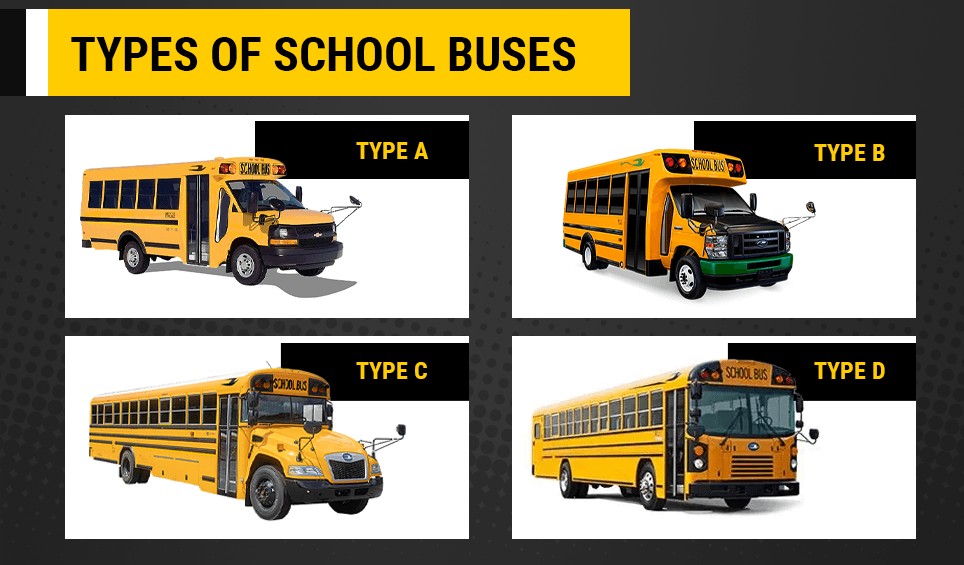School buses are indispensable for student transportation, and the demand is consistently high. Understanding the factors that influence the price is essential whether you’re a school district looking to expand your fleet or considering a used bus. Buying a bus is a significant investment, so it’s crucial to be well-informed.
This guide breaks down the various factors that determine the cost of a bus.
Types of School Buses
There are four primary types of school buses, each designed for specific needs and purposes.
 Type of school buses including Type A, Type B, Type C and Type D
Type of school buses including Type A, Type B, Type C and Type D
Type A Buses
Type A buses are the most compact, built on a van chassis. These buses are known for their maneuverability, making them ideal for navigating congested streets and urban areas. Their design often features a flat or curved nose for easy identification. Type A buses are best suited for smaller groups or routes where space is limited.
Type B Buses
Type B buses share a similar front end to Type A buses but have a larger body. They often resemble a streamlined version of the traditional school bus. Type B buses are frequently used for transporting students with special needs due to their increased capacity, striking a balance between size and functionality.
Type C Buses
Type C buses are the iconic yellow school buses most people envision. They have a distinct hood in the front and are known for their size and power, making them suitable for longer routes with varied terrains. Type C buses are versatile and can accommodate various seating configurations.
Type D Buses
Type D buses, also known as rear-engine buses, feature an engine located in the back. This design provides a quieter ride and improved visibility for the driver. They often have a flat front, earning them the nickname “transit-style” buses. These buses are perfect for heavy-duty routes and transporting larger groups of students.
New vs. Used School Buses
The age and condition of a bus significantly impact its price. New buses will always be more expensive than used ones.
New School Buses
The rising demand for environmentally friendly options and programs like the Environmental Protection Agency’s (EPA) Clean School Bus Program are driving the adoption of electric school buses. According to CNBC, battery-electric Type A school buses can cost around $250,000, whereas gasoline versions range from $90,000 to $95,000. Electric Type C or Type D buses range from $320,000 to $440,000, while diesel versions cost approximately $140,000 to $160,000.
Applying for financing and grants can alleviate the financial burden of fleet renewal. While the initial investment may seem substantial, it can be justified by reduced maintenance costs and a longer service life.
Used School Buses
A well-maintained, relatively new used bus with low mileage is a safer investment. A used school bus with 80,000 to 180,000 miles may cost between $3,000 and $10,000, with prices potentially higher for buses in excellent condition. Schools typically prioritize purchasing new buses, but finding used buses in excellent condition is possible.
Size of the School Bus
The size of a school bus plays a crucial role in determining its cost. Selecting the right bus type ensures it meets your specific needs.
Consider the following factors when choosing the size of your school bus:
- Passenger capacity: Type A and Type B buses have smaller capacities, accommodating 10-30 and 10-45 passengers, respectively. Type C buses can carry 54-90 passengers, while Type D buses can accommodate 72-90 passengers. Generally, buses with higher passenger capacities have higher upfront costs.
- Length: Longer buses typically come with a higher price tag due to increased material and manufacturing costs. However, if you need to transport a large number of students, the extra length may be necessary.
While larger buses are generally more expensive, they are often preferred because they can seat more students, reducing the overall bussing cost per student. In 2023, approximately 25% of survey respondents, including school officials, transportation staff, and company representatives, expressed a preference for Type C or D buses.
Energy Source
Fuel is a significant expense for school bus operations. The energy source affects the complexity of manufacturing, maintenance, and fueling costs. While higher initial investments may lead to cost savings over time through lower maintenance costs, the opposite can also be true.
Diesel Buses
Diesel is the most popular fuel source for school buses. Diesel-fueled school buses range from $140,000 to $160,000, depending on the type.
Electric Buses
Electric school buses (ESBs) typically cost more than diesel buses, ranging from $250,000 to $440,000, depending on the bus type. Electric school buses are quieter, cleaner, and have fewer moving parts. While the initial investment is higher, the lower operating costs and environmental benefits are worth considering.
The exact prices can vary based on your school’s needs, the manufacturer, and location. Weighing the cost of an electric vehicle against the total cost of ownership is essential when deciding whether it is a better choice than diesel.
Propane Buses
Propane costs less than gasoline or diesel and burns cleaner, reducing emissions. It is an attractive option for those seeking eco-friendliness without significant expenses. Propane vehicles have a higher upfront cost, but the lower fuel expenses offset this. Compared to diesel buses, initial costs can be similar due to the additional expenses associated with diesel.
Propane buses also offer a better lifetime cost when considering the vehicle’s lifespan and infrastructure, such as propane tanks. They are easier to maintain than diesel buses, reducing ongoing expenses. Propane fuel pricing is also more stable and lower than diesel prices.
Compressed Natural Gas (CNG) Buses
CNG buses are another eco-friendly option that costs more than diesel buses. The cost savings come from reduced maintenance and lower fuel costs. Like propane, CNG has more predictable costs than diesel fuel. These buses start easily in colder weather and do not require overnight parking in heated facilities. While lifetime costs are lower, the initial cost is higher, averaging $25,000 to $30,000 more than diesel buses.
Upkeep and Maintenance Costs
When evaluating the total cost of a bus, it’s essential to consider its lifetime cost beyond the initial purchase price.
Upkeep costs include fuel and maintenance, which can vary by bus type. Propane and electric buses are generally more affordable to maintain than diesel buses.
School districts concerned about high fleet maintenance costs can implement strategies such as:
- Keeping fewer backup buses: While backup buses can be helpful, they can also increase maintenance costs. Consider the number of backups needed to cover your regular fleet and sell the rest.
- Optimizing routes: Cutting down on the total distance traveled and the number of stops can save on maintenance costs. Staggering school start times so districts can reuse buses for different schools can result in significant savings.
- Strategically buying fuel: Buying more fuel when prices are low can save money. For electric vehicles, charge them outside peak electricity hours to avoid higher energy costs.
- Enforcing safe driving: Ensuring drivers follow speed limits and other rules of the road can save on maintenance costs and keep students safer. Train drivers regularly on safe driving practices.
Conclusion
Understanding the various factors that impact the cost of a bus, from its type and fuel source to its size and maintenance requirements, is essential for making an informed decision. Whether you are opting for a new, environmentally friendly electric bus or a reliable used model, careful consideration of these factors will help you find a vehicle that meets your needs and budget.
